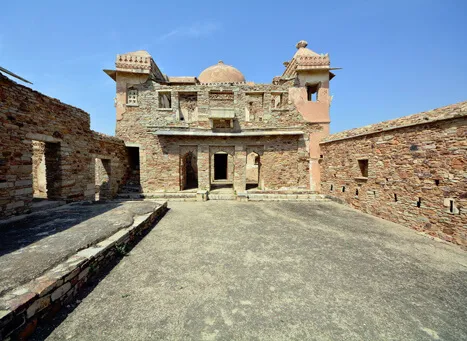
Ratan Singh Palace: A Regal Gem in Chittorgarh
Located within the sprawling Chittorgarh Fort in Rajasthan, Ratan Singh Palace stands as a majestic testament to Rajput architecture and royal heritage. This grand palace, named after Maharaja Ratan Singh, offers a glimpse into the opulent lifestyle and architectural brilliance of medieval Rajasthan. For history enthusiasts, architecture admirers, and travelers interested in Rajasthan’s royal past, Ratan Singh Palace is a must-visit destination.
Historical Background
Ratan Singh Palace, built during the 14th century, was constructed by Maharaja Ratan Singh, the ruler of Chittorgarh. The palace is situated within the formidable Chittorgarh Fort, a UNESCO World Heritage Site renowned for its extensive fortifications and historical significance.
The palace is closely linked with the legendary figure of Rani Padmini, Maharaja Ratan Singh’s queen, and the dramatic events surrounding her. The story of Rani Padmini, her beauty, and the subsequent siege of Chittorgarh by Alauddin Khilji is a central narrative in Rajput history and folklore. Although the palace is not as well-preserved as some other historical sites, it retains a significant place in the region’s heritage.
Architectural and Scenic Features
1. Majestic Structure
Fortified Design: Ratan Singh Palace, like many Rajput structures, was designed with both grandeur and defense in mind. The palace is integrated into the Chittorgarh Fort’s defensive architecture, offering strategic views of the surrounding landscape.
Intricate Carvings: The palace features traditional Rajput architectural elements, including ornate carvings, decorative arches, and beautifully designed courtyards. The intricate stonework reflects the artistic and architectural skills of the period.
Elegance and Simplicity: While the palace’s design may appear austere compared to some other Rajput palaces, its elegance lies in the simplicity and functionality of its structure. The use of local materials and the integration with the fort’s defenses highlight the practicality and beauty of Rajput architecture.
2. Scenic Ambiance
Panoramic Views: The palace offers stunning panoramic views of the surrounding landscape, including the fort’s expansive walls, bastions, and the city of Chittorgarh below. The elevated position of the palace provides a dramatic backdrop for exploring the fort’s history.
Peaceful Retreat: The area around Ratan Singh Palace provides a serene escape within the fort’s bustling environment. The palace’s quiet courtyards and ancient walls evoke a sense of timelessness and tranquility.
Cultural and Historical Significance
Ratan Singh Palace is an important cultural and historical site due to its association with Maharaja Ratan Singh and the legendary Rani Padmini. The palace is part of the larger Chittorgarh Fort complex, which played a crucial role in Rajput history and defense. The events surrounding the siege of Chittorgarh, particularly the tale of Rani Padmini’s courage and sacrifice, are central to the region’s cultural heritage.
Visiting Ratan Singh Palace provides valuable insights into the royal life of the Rajput era and the architectural accomplishments of the time. The palace is a symbol of Rajput pride, bravery, and the rich historical legacy of Chittorgarh.
Visiting Ratan Singh Palace
Ratan Singh Palace is located within the Chittorgarh Fort, making it accessible as part of a visit to the fort. The best time to visit is from October to March when the weather is cooler and more comfortable for exploration.
Here are some tips for your visit:
Guided Tours: To fully appreciate the history and significance of Ratan Singh Palace, consider joining a guided tour. Knowledgeable guides can provide detailed information about the palace’s architecture, history, and its place within the larger context of Chittorgarh Fort.
Photography: The palace’s architecture and scenic views offer great opportunities for photography. Be sure to check for any photography restrictions and respect the guidelines.
Comfortable Footwear: The fort and palace involve considerable walking and exploration. Wear comfortable footwear and be prepared for uneven terrain.
Explore Chittorgarh Fort: While visiting Ratan Singh Palace, take the time to explore other notable structures within Chittorgarh Fort, including the Vijay Stambh (Victory Tower), Kirti Stambh, and Rani Padmini’s Palace. These sites complement your visit to Ratan Singh Palace and offer a broader understanding of the fort’s history.
Experience Regal Heritage
Ratan Singh Palace stands as a regal reminder of Rajput heritage and architectural achievement. Its historical significance, combined with its architectural elegance and scenic beauty, makes it a valuable destination for anyone exploring the rich history of Rajasthan.
So, when you visit Chittorgarh, make sure to include Ratan Singh Palace in your itinerary. Experience the grandeur of Rajput architecture, immerse yourself in the rich historical narrative, and appreciate the serene beauty of one of Rajasthan’s most significant landmarks.
Discover the regal charm of Ratan Singh Palace, where history, architecture, and scenic beauty converge to create an unforgettable experience. Explore the heritage of Chittorgarh and be inspired by the timeless legacy of this magnificent palace.
